Shep Hyken's Blog, page 182
September 21, 2016
There’s Very Little Loyalty When You Compete On Price
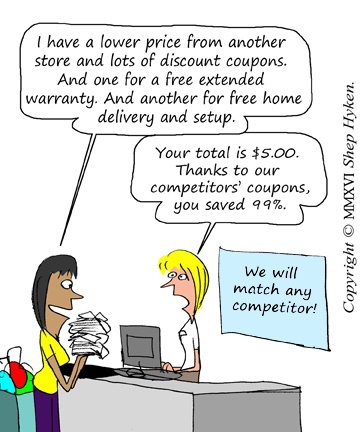 It doesn’t matter if you are in retail selling to consumers, or in a business that sells to other businesses, it is virtually impossible to create customer loyalty by being the lowest price provider.
It doesn’t matter if you are in retail selling to consumers, or in a business that sells to other businesses, it is virtually impossible to create customer loyalty by being the lowest price provider.
Consider this. Low price shoppers are loyal to their wallets and purses, not to the business. As soon as these price-conscious customers find a retailer or any other type of business or vendor with a lower price than the one they have been doing business with, they will move. It’s all about dollars. The retail industry has trained consumers to think that way.
Some businesses have a loyalty or membership card that offers deeper discounts, and you would think that is a way to grab some loyalty. But, that only lasts until a competitor matches the discount programs. You see, if it’s easy to copy what you are doing, then others will eventually copy it.
So, I thought about how a retailer – or any business for that matter – could create some loyalty and still be a low price provider. One way might be through having some exclusivity of a line of merchandise that other low-price retailers might not have access to. The combination of a low price with exclusive merchandise can work.
For any type of business, an emotional connection between the customer and the company can create loyalty. It can be a person or team at a company or store. Or, maybe there is a community project or charity that the business affiliates with that can build a connection beyond price with a customer. Yet notice that both of these are trying to move away from price being the sole reason a customer does business with a company. These types of connections make price less relevant.
Of course I can always preach customer service as the way to attract customers and make them loyal. But, that is much more difficult if the company is focused on low pricing as a strategy. It doesn’t mean you can’t have friendly and even helpful service. It’s just harder to do so while keeping prices low.
So, rather than have a low price strategy, consider a competitive price strategy. A bit higher than the low price keeps you in the game, provided you deliver a better level of service or an amenity that the competition doesn’t offer. In other words, you deliver value. A competitive price, not necessarily the lowest price, combined with good service is a winning combination that can help you win the competitive game of business. Just remember, that if you choose to compete primarily on price, be sure to always be the lowest price, or be prepared to lose customers.
Shep Hyken is a customer service expert, keynote speaker and New York Times bestselling business author. For information contact or www.hyken.com. For information on The Customer Focus™ customer service training programs go to www.thecustomerfocus.com. Follow on Twitter: @Hyken
(Copyright © MMXVI, Shep Hyken)
Save
Save
Save
Save
Save
The post There’s Very Little Loyalty When You Compete On Price appeared first on Shep Hyken.
September 20, 2016
Amazing Business Radio: Shai Berger
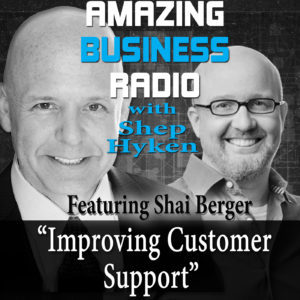
Shai Berger on Improving Customer Support
Shep Hyken speaks with leader, innovator, call center educator, and co-founder and CEO of Fonolo, Shai Berger about improving customer support. They discuss some of the friction points customers have when dealing with companies, and Shai offers great tips and solutions for eliminating these pain points. Do you want to provide a better customer support experience? You should, and this episode of Amazing Business Radio will help you do just that!
“There should be a way to get to a live agent, and it should be friction-less and as pleasant as possible.” – Shai Berger
Save
The post Amazing Business Radio: Shai Berger appeared first on Shep Hyken.
September 19, 2016
5 Top Customer Service Articles For the Week of September 19, 2016
Each week I read a number of customer service articles from various online resources. Here are my top five picks from last week. I have added my comment about each article and would like to hear what you think too.
The Customer Service Strategies Behind Zappos’s Success by Sharpen
(Sharpen) The power behind the Zappos brand and majority of their success is attributed to the power of fantastic customer service, which is often overlooked as a sales strategy.
My Comment: It’s been a while since I’ve read an article about Zappos and their amazing service. This one came into my inbox and it is great one. There is so much we can learn from Zappos and Tony Hsieh. This article is filled with comments about the company’s culture, empowering employees and much more.
10 Tips For Making Customers Feel Welcome by Richard R. Shapiro
(TCFCR) Here are my ten tips for making customers feel welcome.
My Comment: Here is a great article with ten tips that will not only make customers feel welcome (as the title indicates), but are good customer service strategies overall. While you may be familiar with some of the tips on the list, there are a few that have a defferent twist.My favorite is the first one, which is to “Give customers hope.” Your words can make a customer feel as if they have called or come to the right place. Simple yet, very powerful.
How to Avoid Creating a Negative Culture of Cynicism and Sabotage by Tracy Maylett
(Switch and Swift) Some employers fall victim to scare-tactic polls that report 80 percent of employees are either running for the exits, job hunting, or sabotaging their businesses from within as a result of a negative culture. On the other by, there are employees who’ve become jaded in the wake of “engagement” projects that are insulting, inauthentic, inept, or all of the above.
My Comment: Most companies that are known for their excellent customer service are also known for the excellent employee culture. This article takes a look at the inside of the organization, and how an improved culture can increase productivity, reduce turnover, enhance customer service and more. Happier (fulfilled and engaged) employees can mean a better experience for your customers.
To Boost Customer Service, Wow Your Primary Customers—Your Employees by S. Chris Edmonds
(CRM) The key to consistent, caring customer relationships is a purposeful, positive, productive culture.
My Comment: Just after I read the article by Tracy Maylett on how to avoid creating a negative culture in your organization, I came across this excellent article that proves the importance of focusing on your “primary customer” – your employees. The author writes that the key to consistent, caring customer relationships is a purposeful, positive, productive culture. And, then he proves it.
Are customer service chatbots full of chit? by Suzie Blaszkiewicz
(GetApp) Chatbot. No, it’s not a 21st century nickname for your friend who won’t stop talking. A chatbot, short for ‘chatterbot’, is the latest revived craze among tech experts and businesses looking to use cutting edge technology to get a leg up on the competition.
My Comment: Chatbots are a hot topic in customer service. This is the text box that pops up on a website that allows you to interact with the company. You can ask questions about the products, get support and more. You might even think you’re dealing with a person, but you’re actually interacting with a computer. Is this a good or bad technology? Does using chatbot technology make it better for the company or the customer? I’ll let you decide. (Personally, I think it’s good when a company invests in the right system.) After reading this article, you’ll have an even better understanding of this powerful technology and why it’s growing in popularity.
Shep Hyken is a customer service expert, professional speaker and New York Times bestselling business author. For information contact or www.hyken.com . For information on The Customer Focus™ customer service training programs go to www.thecustomerfocus.com . Follow on Twitter: @Hyken
Save
The post 5 Top Customer Service Articles For the Week of September 19, 2016 appeared first on Shep Hyken.
September 16, 2016
Guest Blog: Persona-lizing the Customer Experience
This week on our Friends on Friday guest blog post my colleague, Mark Smith, writes about how crucial personalization can be to the customer experience. When you customize or personalize the experience, even during the sales process, you are delivering a better level of service. – Shep Hyken
Personalization, according to the definition we are now familiar with, has been around since the dotcom bubble in the late 90s. Originally, retailers used this concept to make their services more appealing to consumers by showing products and services that might match their particular preferences. Today, modern consumers demand personalization in the form of varied yet tailored content across an assortment of channels that have become popular in the last decade. To achieve this demand for optimized personalized content, marketers must be up-to-date on the best ways to understand their consumers and where they are most likely to shop.
However, according to Gartner, less than 10% of top retailers in the US believe they are highly effective at personalization and nearly one-third report having limited or no capacity to support personalization efforts. But Why? While marketers today are challenged with making sure they have the best technology to leverage available data to drive more personalized experiences, many don’t know where to start.
Instead of drilling down to the individual customer level to achieve effective personalization, marketers can instead try “personification,” a term recently created by Gartner. The concept focuses on groups of consumers with similar characteristics rather than every specific individual. With this principle in mind, consider applying these 5 steps to your own marketing department:
Set your data free: A company’s data is useless if it can’t be leveraged towards business goals. Rather than spending lots of money on a brand new central database, make breaking down data siloes your company’s immediate priority. Unifying actionable data (taking it out of the various departments and locations where it is stored separately) in a location accessible to all, increases data availability and improves communication and collaboration across siloes.
Segment your core audience: As core audiences are not usually homogenous, it’s important to break down your audience into smaller, more manageable groups based on shared attributes. To do this, run basic analyses to determine which traits are most common in an audience and break the group into segments accordingly. Tailored marketing activities to these specific target audience segments will be more effective.
It’s time to persona-lize: Next, identify the target personas within those audiences. If a segment of a retailer’s audience is “18-24-year-old males,” a persona within that could be “college student” or “athlete.” Once created, it is essential to continually monitor behaviors within segments to identify commonalities and make predictions about future behavior, knowledge essential to crafting effective personalization.
Test the waters: With your audience properly segmented and effectively understood, it’s time to try out marketing tactics across various channels. While time-consuming, this step is critical to understand how to most efficiently reach and convert different groups in your future marketing campaigns. In this step, it is critical to set hypotheses – “18-24-year-old males will be more responsive to sponsored Facebook posts than search ads” – and then test them rigorously to which channels and which messages respond best to your persona-lization.
Score your performance: Finally, it is essential to define goals and specific KPIs to measure outcomes with these audiences moving forward. Basic examples of KPIs include visitor engagement, cart abandonment, bounce rate and conversion rate, but Google Analytics can be used to define and measure practically any goal.
 With over 20 years of global experience in Marketing Applications and Analytical CRM, Mark Smith is a leader in building, growing and managing successful companies. Currently in “innovation mode” as the President of Kitewheel, Mark is focused on helping marketing agencies deliver better consumer engagement through solutions that unify the “logic” layer of today’s customer-facing technology for their large brand clients. Mark is a regular at industry conferences and events and shares his insights on customer journeys, omni-channel marketing, solutions sales leadership and high-tech marketing.
With over 20 years of global experience in Marketing Applications and Analytical CRM, Mark Smith is a leader in building, growing and managing successful companies. Currently in “innovation mode” as the President of Kitewheel, Mark is focused on helping marketing agencies deliver better consumer engagement through solutions that unify the “logic” layer of today’s customer-facing technology for their large brand clients. Mark is a regular at industry conferences and events and shares his insights on customer journeys, omni-channel marketing, solutions sales leadership and high-tech marketing.
For more articles from Shep Hyken and his guest contributors go to customerserviceblog.com .
Read Shep’s latest Forbes Article: How To Celebrate National Customer Service Week
Save
Save
The post Guest Blog: Persona-lizing the Customer Experience appeared first on Shep Hyken.
September 14, 2016
The Three Words that Describe Your Company
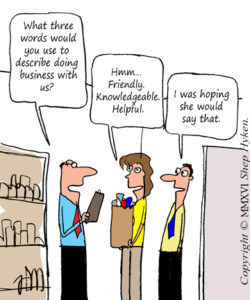 I’m very excited to share this concept with you, especially as we approach National Customer Service Week. If you’ve been following me for longer than a year, then you know that Customer Service Week is the first full week of October, and this year it’s October 3-7. So, as we approach this year’s customer focused holiday, I want you to consider working through an exercise that will help you create a better customer service experience.
I’m very excited to share this concept with you, especially as we approach National Customer Service Week. If you’ve been following me for longer than a year, then you know that Customer Service Week is the first full week of October, and this year it’s October 3-7. So, as we approach this year’s customer focused holiday, I want you to consider working through an exercise that will help you create a better customer service experience.
By the way, in addition to this, I’ll have five short videos that are released on my YouTube channel on each of the five days. The easiest way to get to it is www.ShepTV.com. Just scroll down to the heading that reads Customer Service Week.
Now, back to the exercise. I want you to pull out a piece of paper and write down three words you would want your customers to say about you after they have done business with you. Let me share some examples to start your creative process.
You might want people to think of you as easy, friendly and knowledgeable. Easy in that you are easy to do business with, no friction or hassle. Friendly in that your people are genuinely friendly and care about their customers. Knowledgeable in that your people are smart and knowledgeable, and have an expertise that creates confidence for your customers.
Other words might be quick, as in quick to respond, empathetic, caring, fun, edgy, high-end, conservative – You get the idea. The list can go on and on. There are many, many words you can use to describe a business or someone in a business. You might ask some of your happier customers to come up with three words. See if they match yours. Or, if you’re really good, they may come up with even better words than the ones you thought of.
Once you have your words, the question becomes simple. After interacting with a customer, and that also includes your internal customer, also known as someone you work with, would they agree that these three words describe you? If so, you’ve delivered. If not, you now have an opportunity to improve.
Sounds like a simple exercise, and for some it will be. Yet, for others it will prove difficult. Coming up with the three adjectives is the easiest part. Your customers agreeing with you is the big challenge. If you ask them what three words they would use to describe you, they may not come up with the same three you did – although in a perfect world they would. As an alternative, you may want to ask if they agree with your three words. Then, and this is important, ask why.
Don’t let the simplicity of this exercise fool you into thinking it is trivial or anything less than powerful. If the three words are truly representative of the experience you create for your customers, you must relentlessly promote these three words internally. This is part of your definition of great service. You must train people to deliver on these three words. It must be sewn into the fabric of your culture.
Shep Hyken is a customer service expert, keynote speaker and New York Times bestselling business author. For information contact or www.hyken.com. For information on The Customer Focus™ customer service training programs go to www.thecustomerfocus.com. Follow on Twitter: @Hyken
(Copyright © MMXVI, Shep Hyken)
Save
Save
Save
Save
The post The Three Words that Describe Your Company appeared first on Shep Hyken.
September 13, 2016
Amazing Business Radio: Bill Gessert
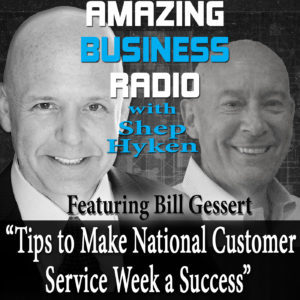 Bill Gessert Shares Tips to Make
Bill Gessert Shares Tips to MakeNational Customer Service Week a Success
Shep Hyken speaks with writer, speaker, and President of the International Customer Service Association (ICSA), Bill Gessert about National Customer Service Week. (This year the dates are October 3-7, 2016.) They discuss the background and history of this week, which includes a Presidential Proclamation, and discuss the importance of appreciating both your external and your internal customers (the people you work with). In addition to sharing ideas that your entire company can celebrate, they also provide great tips for making this special week successful. If you want to make your National Customer Service Week a success, you can’t miss this episode of Amazing Business Radio!
“It’s not so much the mistake, it’s your ability to recover from it.” – Bill Gessert
Save
Save
Save
Save
Save
The post Amazing Business Radio: Bill Gessert appeared first on Shep Hyken.
September 12, 2016
5 Top Customer Service Articles For the Week of September 12, 2016
Each week I read a number of customer service articles from various online resources. Here are my top five picks from last week. I have added my comment about each article and would like to hear what you think too.
4 ways to influence social influencers by Lyle Stevens
(internet Retailer) In an age of promotional clutter, go the extra mile to excite the influential people who are dedicated to your brand.
My Comment: Influence marketing is about getting influential people to talk about you and what your company sells. It’s a more sophisticated version of word-of-mouth marketing. This article may get you thinking about how to target the influencers in your industry, which may be industry experts or your most “influential” customers.
Speed Is Best Measure of Customer Experience by Gerry McGovern
(CMSWire) The basics of customer experience is helping people do what they want to do. However, if you want to excel in customer experience you must help people do what they want as quickly as possible.
My Comment: Speed has become an important part of the customer experience. Customers want items shipped and delivered quicker. They want a fast response to inquiries, questions and complaints. Here is a fascinating article with some stats and facts about speed and CX in the digital world. Check out this statistic: For every secon faster Walmart.com has been able to make its pages’ load, it has a 2 percent lift in conversions. (Wow!)
The elves of summer by Jim Serger
(Current in Carmel) Summer is at its conclusion — not forgetting, though, the elves that made this summer more enjoyable.
My Comment: This is an interesting article. The author publically thanks the people who made his life more enjoyable. He didn’t use names, but described what they did. Hopefully this article will prompt you to thank some of the people who made a difference in your life and/or business. People, especially our customers, want to know they are appreciated. Take a few minutes to thank someone in person, write a note, send an email or make a phone call.
8 Etiquette Tips to Inspire Customer Loyalty by Diane Gottsman
(Huffington Post) The first step is providing clients with a great product or service. Without this basic foundation, there is no relationship, only your customer disappearing in search of someone else who can meet their needs. Once this is in place, remember these 8 ways to build a bond that will help remind your clients how they benefit by working with you – and encourage a return visit.
My Comment: Etiquette is an interesting word, and when used to suggest better etiquette begets customer loyalty, I take notice. Here are some simple, common sense tips to building a better relationship with your customer – that can ultimately lead to repeat business and loyalty.
Skyrocket SaaS Growth: 56 Must Read Tips From Top SaaS Companies by Adam Feber
(Chargify) To help you sort through the best of the best resources, we’ve compiled a roundup of our most popular tips posts featuring 56 tips from rockstar companies such as Buffer, Zendesk, InvisionApp, Hubspot, Groove, Asana, Trello, Basecamp, and many, many more.
My Comment: Don’t be misled to thinking this article is for just SaaS types of businesses. There are many tips here that apply to all business in all industries. The “Customer Success” tips (I’ve mentioned these in a past Top Five blog) are invaluable, and I’m sure you’ll find some other great tips from the other topics as well.
BONUS
20 Must-Read Books for Anyone Who Does Customer Service (UPDATED!) by Len Markidan
(Groove) These books will change the way you look at customer support.
My Comment: As a “bonus” to the top five list(I guess that makes it a top six list), I thought you might enjoy this list of Len Markidan’s list of “20 Must Read Books for Anyone Who Does Customer Service.” Happy Reading!
Shep Hyken is a customer service expert, professional speaker and New York Times bestselling business author. For information contact or www.hyken.com . For information on The Customer Focus™ customer service training programs go to www.thecustomerfocus.com . Follow on Twitter: @Hyken
Save
Save
Save
Save
The post 5 Top Customer Service Articles For the Week of September 12, 2016 appeared first on Shep Hyken.
September 9, 2016
Guest Blog: Is your Business Really Focused on Client Satisfaction? Is your Business Really Client-Centered?
This week on our Friends on Friday guest blog post my colleague, Anne Bachrach, reminds us of the importance of running a client-centered business and how this will set you up for success. Sometimes, all it takes is giving someone a little extra time or giving a little extra effort. – Shep Hyken
There are many factors that go into building a successful business. However, one of the most important, yet one of the most ignored, is focusing on creating client satisfaction. Create a client-centered business and you’ll ensure that your business gets only rave reviews, while setting it up for success.
Client Satisfaction
Are your clients’ interests at the core of your business? If not, your business will remain at a standstill for years to come. Many business owners have the perception that they run a client-centered business, but in reality, they have gotten into a bad habit of putting their own personal interests in front of their clients’. Yes, it is true that you should have a personal interest and passion for your business, but your interest is not what drives sales. Meeting your clients’ needs and delivering stellar client service is what drives sales and generates revenue.
Smart business owners know that running a client-centered business is necessary in order to stay ahead of the competition. After all, when you focus your efforts on client satisfaction, your clients will become your biggest free marketing tool. Not only will they become lifetime clients, but they will also refer you to friends, family members, and colleagues any chance they get. Word of mouth, any successful business owner will tell you, is the most powerful marketing tool available.
In addition, once you build a large base of loyal clients, you can begin to scale back on marketing costs because your loyal client base will peddle your business for you! High client satisfaction helps pave the path to business growth and success.
Filling the Gap
In order to ensure client satisfaction, you must offer the services that your clients seek. A novel idea is only a novel idea. There must be a market for your idea and clients in need of it.
While you can offer many of the other standard services your competitors offer, you should not rely solely on them. Why would you? If you do just settle for offering what everyone else is selling, there’s nothing to differentiate you from your competition. At that point, you’re almost forced to compete on price to acquire clients. If people perceive you as a commodity, it is hard to differentiate your business and receive what you deserve and want. How do you get past this? You get past it by identifying the services that your clients really want, but no one else is offering. Maybe you will offer more client service options or something that is just a little better than everyone else. It doesn’t always have to be a big difference to create a big separation between you and others.
If you are already running your own business, and your clients are sharing their honest feedback with you, it’s bad business sense to ignore what your clients are telling you they want! It may not seem like it, but what they are providing you is very valuable information.
The market research business draws big money for one main reason: there are people and businesses eager to know what clients need and want! They are not only very willing to pay for the information, they are also very willing to provide exactly what clients need and want! Take note when a client offers you feedback, because you have a golden opportunity to give them exactly what they need and want! The importance of this cannot be emphasized enough – when you know what your clients need, you can create a client-centered business and deliver what they need – growing your business.
By focusing in on niche markets that aren’t being served, you can satisfy clients by offering them the services that they need, but are not currently available. This separates you from your competition and frees you from competing solely on price. In fact, thanks to the rules of supply and demand you can even charge a premium for these services because they’re so scarce!
Regardless of your industry, performing market research is important in offering the right products. What’s the first thing most modern-day shoppers do when they’re in the mood to make a purchase? They perform an internet search on the product or service to do some comparison shopping. You can use this to your advantage to identify what your clients are after but just aren’t able to get anywhere else.
Given the popularity of online services, it is important to be sure your business has an online presence so when potential clients search for services like yours, they can find you. Remember, the key is to fill the gap and focus on creating a stellar client-centered business.
If you’re focused on client satisfaction, then all of your clients will likely become lifetime clients and become a free source of marketing when they eagerly refer their friends, family, coworkers, and everyone they know to you. If your clients aren’t eagerly referring you to everyone they know, then maybe you need to evaluate how you can be even more client centered so when you ask (and even when you don’t), they are happy to introduce you to a lot of people who can use your products and services. Continue to be open to making changes that can enhance being client-centered and you will improve the opportunity to be successful. When you run a client centered business, you will run a business set up for success.
Anne M. Bachrach is known as The Accountability Coach™. She has 23 years of experience training and coaching. Business owners and entrepreneurs who utilize Anne’s proven systems and processes work less, make more money, and have a more balanced and successful life. Anne is the author of the books, Excuses Don’t Count; Results Rule!, and Live Life with No Regrets; How the Choices We Make Impact Our Lives, and The Work Life Balance Emergency Kit. Get 3 FREE gifts including a special report on 10 Power Tips for Getting Focused, Organized, and Achieving Your Goals Now
For more articles from Shep Hyken and his guest contributors go to customerserviceblog.com .
Read Shep’s latest Forbes Article: Panera Bread Moves Into The Era Of Convenience
Save
The post Guest Blog: Is your Business Really Focused on Client Satisfaction? Is your Business Really Client-Centered? appeared first on Shep Hyken.
September 7, 2016
Sometimes It’s Okay to Ask a Customer to Repeat the Story
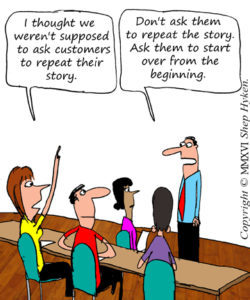 Customer Opportunity
Customer Opportunity
Just last week I wrote an article about companies that ask customers to repeat their problems, account numbers and more. So consider this a follow-up to that article that approaches the subject from a completely different angle. For example, getting transferred from one customer service representative to the next and having to repeat the issue. Or when a customer is asked to use the touchpad on their phone to type in their account number, only to be asked for the same number when the customer support representative finally connects with the customer.
Having to repeat information is frustrating and a waste of everyone’s time – usually. But, sometimes it’s okay to ask a customer to repeat their story. But, it has to be the right time. This is how it works.
First, let’s hope that customer has not been abused by being asked repeatedly for account information or having been passed from one customer support rep to the next. And, even if they have talked to two or three reps, this still works, provided, and this is important, you are the last person they have to share the story with.
So, the customer calls and they are upset. You start by acknowledging their issue and apologizing for the problem. You’re just starting to make them feel better. They may even believe, because of your positive attitude about helping them, that you are the one that will resolve their issue. This customer has told you the story. It is extremely important that you let this customer know that you are the one that is now in charge of making him or her happy. But, this will only work if you truly have been empowered to do so. You can’t move this customer to another support level. If, for some reason you do, then you have to stay with them until the issue is resolved.
This is when you ask them to repeat their story, and this is how you ask: “Again, I’m sorry for the frustration you’re having. I’m going to ask you to start over from the beginning. I want to make sure I understand exactly what happened. I may have a few questions and I may even take some notes so I can completely understand what happened. I’m here to help you.”
Obviously you’ll need to modify this to suit the specific issue, but this is generally how it works. Now, there are a few key points to remember.
One, you apologized again.
Two, you didn’t use the word repeat. You asked the customer to start over from the beginning. This is crucial language.
Three, you mentioned you might have a few questions, and you should. This shows the customer that you are listening.
Four, you mentioned you would be taking notes. The customer may hear you typing in the background and you don’t want to be perceived as multi-tasking. Because you’re taking notes, it will demonstrate that you’re fully engaged in understanding the problem.
Fifth, actively listen to the customer. Use encouraging words and sounds such as uh huh, oh, ok, or I understand, to show you’re listening. And reinforce your understanding even more by restating their issue back to them for example “What I’m hearing is… “or “Sounds like what you’re saying is…” and summarize the issue back to them to ensure you fully understand their problem.
By handling the situation this way, you are moving the customer who may be on a rant, to the opportunity to vent. As the customer vents about the problem, you may notice that he or she is starting to relax. Anger is turning into a confident attitude about the situation potentially being resolved.
If all goes well, you will resolve the issue and the customer will feel good about you and your company. Worst case, if it turns out someone else has to be involved, this customer feels they have an ally as you follow through with the customer.
Nobody – and no company – is perfect. There will be complaints. But, the customer’s discontent or anger shouldn’t escalate after he or she has called the support center. A problem handled well may actually increase the customer’s confidence in the company to a level that’s even higher than if the problem had never happened at all.
Shep Hyken is a customer service expert, keynote speaker and New York Times bestselling business author. For information contact or www.hyken.com. For information on The Customer Focus™ customer service training programs go to www.thecustomerfocus.com. Follow on Twitter: @Hyken
(Copyright © MMXVI, Shep Hyken)
Save
Save
Save
Save
Save
The post Sometimes It’s Okay to Ask a Customer to Repeat the Story appeared first on Shep Hyken.
September 6, 2016
Amazing Business Radio: Colin Shaw
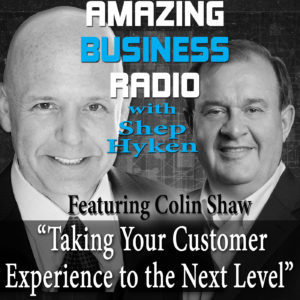 Colin Shaw on Taking Your Customer Experience
Colin Shaw on Taking Your Customer Experienceto the Next Level
Shep Hyken speaks with founder and CEO of Beyond Philosophy and bestselling author, Colin Shaw. They discuss Colin’s new book “The Intuitive Customer: 7 Imperatives for Moving Your Customer Experience to the Next Level.” Colin shares tips to help you understand your customer’s behaviors and how you can use that to increase sales. Is customer service important to you? Is sales important to you? Then, this episode of Amazing Business Radio shouldn’t be missed!
Click here to listen and subscribe to Amazing Business Radio on iTunes.
“People buy emotionally, and then they justify with logic.” – Colin Shaw
Save
Save
The post Amazing Business Radio: Colin Shaw appeared first on Shep Hyken.







